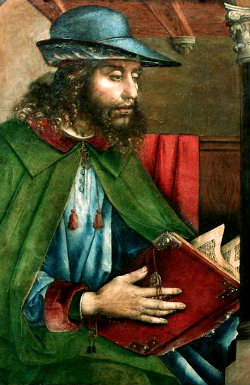Search:: Artists Alphabetically Artists by Country Artists by Century Artists by Movement
Pedro Berruguete
1450 - 1504
Spanish Early Renaissance Artist
Influences: Melozzo da Forlž, Michelangelo, Giovanni di Paolo and Sassetta
First Great Renaissance Painter in Spain Pedro Berruguete lived during a time of political unrest and social upheaval. Europe was torn asunder by the Spanish Inquisition, social strife and warfare. The world was in transition. Christopher Columbus discovered the New World. The Italian Wars led to the collapse of the Italian city-states and for a time anarchy and turmoil reigned. Despite the madness people were becoming curios about modern science, art and philosophy. Spain, Pedro Berruguetebirth place, was an enchanting land of olive trees, vineyards, wine, rich cheeses, beautiful architecture, magnificent art and adventure. Pedro Berruguete painting technique was a perfect combination between the 0ld style Gothic manner and the new Renaissance style. John C. Van Dyk, art historian and author explains, "Berruguete studied with Michelangelo, and is supposed to have helped him in the Vatican. He afterward returned to Spain, painted many altar-pieces, and was patronized as painter, sculptor, and architect by Charles V. and Philip II. He was probably the first to introduce pure Italian methods into Spain, with some coldness and dryness of coloring and handling. "The newly emerging painting techniques and styles were a reflection of the transformation that was taking place in Europe, the change from the Dark Ages to a more enlightened, tolerant society. According to Historian Hendrik van Loon, "People were tremendously alive. Great states were being founded. Large centres of commerce were being developed. High above the turreted towers of the castle and the peaked roof of the town-hall, rose the slender spire of the newly built Gothic cathedral. Everywhere the world was in motion. The high and mighty gentlemen of the city-hall, who had just become conscious of their own strength (by way of their recently acquired riches) were struggling for more power with their feudal masters. "About The High Renaissance Period
Classical humanism, was a major aspect of the Italian Renaissance. This intellectual movement was based on the idea that every persons life had value and dignity. Humanism also stressed man's position in the natural world. The Humanists believed modern man should look to the classical writings and art of the ancient Greeks and Romans as exemplary guides for ethical living and scholarship. John Donne, famous Renaissance poet and writer stated, "No man is an island. entire of itself; every man is a piece of the continent, a part of the main; if a clod be washed away by the sea, Europe is the less, as well as if a promontory were, as well as if a manor of thy friend's or of thine own were; any man's death diminishes me, because I am involved in mankind, and therefore never send to know for whom the bell tolls; it tolls for thee. ."
During the Renaissance the spirit of an era awoke, revitalized with knowledge and creativity. Although art still served a specific functions, which were primarily religious, painters added more of their individual spirit and personal vision to their creations. John Ruskin, famous art historian declared, "The art of any country is the exponent of its social and political virtues . The art, or general productive and formative energy, of any country, is an exact exponent of its ethical life. you can have noble art only from noble persons, associated under laws fitted to their time and circumstance."
The major painters of the Renaissance were not only artists but men of great genius who gave the world their great intellectual gifts. Florentine and Venetian painting were both formed by extraordinary personalities. These independent creative geniuses tackled mathematical, artistic and philosophical problems of the highest interest, and presented solutions that have never lost their value. The sense of humanism pervading renaissance painting is still palpable. The painters touched on a multitude of issues regarding the human condition - death, love, reason, religion, universal morality, social problems.
Key Descriptive Words and Phrases associated with the Renaissance Movement - rebirth, rediscovery of the classical world, City-state, Humanism, Humanist, Francesco Petrarch, Reform, The Prince, Theocracy, The Inquisition, Human Reasoning, publication of Della Pittura, a book about the laws of mathematical perspective for artists, sfumato, chiaroscuro, linear perspective, Heliocentric Theory, vanishing point, Savonarola, spiritually significant, illuminated manuscript, idealized biblical themes, scriptorium, emotion, illuminator, Age of Discovery, axonometric drawing, curiosity about the natural world, mythology, realistic use of colours and light, Bonfire of the Vanities, Old Testament stories, ethereal and foggy backgrounds, Gospel parables, The Blackdeath, romanticized landscapes, Christian symbolism.
☼☼☼☼☼
Famous
Quotes From Painters of the Renaissance Art Era
A beautiful body perishes, but a work of art dies not. Leonardo
da Vinci quote
The
painter has the Universe in his mind and hands. Leonardo da
Vinci quote
I
saw the angel in the marble and carved until I set him free. Michelangelo
Require more facts and information about artists of the renaissance era? Poke around every nook and cranny of the known universe for information this subject. Search Here
© HistoryofPainters.com If you like this page and wish to share it, you are welcome to link to it, with our thanks.
